While considering my main goal for the rapid ideation sprint, I decided to focus upon my ideation and design. These are areas I typically do not spend significant effort on, preferring to get right into the code and start with something minimal and then build it out.
To make the goal measurable, I sketched out a time-blocked plan where more than 1/2 of the effort was spent on research, ideation and design. I also wanted to improve my personal sense of skill in design tools. This wasn’t quite as objectively measurable but is something I can reflect upon.
Objectives
During the research and preparation, I decided I wanted to try and make a game in a non-standard game toolkit, and evaluated Vue.js, React, Angular in addition to Unity. I really enjoyed the unity tutorials and demo projects but felt that using a more web-based framework would have more cross-over benefits for my day job.
I have used sketches in recent weeks, as I prefer to draw freehand, I think it helps my ideas flow. I often make extensive use of whiteboards when thinking or explaining my thinking. I wanted to explore the use of more formal tools, such as Miro or Adobe XD. Additional time was spent on tutorials and exploring these tools. As part of the design process, I wanted to make use of more of the processes laid out in earlier learning sessions, as I do not believe I explored them as fully as I could have. I made multiple iterations on mind-maps and workflow tools to try and refine the game mechanics.
Time management has always been hit and miss, and by planning my time in day-long boxes, I could be clear to move onto new tasks without overthinking the previous requirements. This would also ensure I spent the required amount of time on research, planning and design before diving headlong into development. Initial Learnings
I really enjoyed the research elements, watching tutorials and performing practicums on the tools. I found that Unity, which I had previously been quite worried about using, due to me not knowing C#, was not nearly as daunting as I expected. My years of C, PHP and Python coding transfer pretty easily.
Discussing the original game ideas with my wife really helped flesh out the concept, and I came up with the idea of doing a hybrid incremental & roguelike game with frequent deaths, resetting time and gradually increasing your abilities. This came about from a conversation about how long the pirate era really was, limiting the ability for a pure incremental which goes on forever.
The formal ideation process further built out the idea, growing into what became quite an overwhelming connected list of options, levels, scenarios, missions, upgrades and skills. Transforming this into a game flow became overly complex very quickly, required me to go back to a mindmap to filter out a lot of the functionality.
I was able to build out a basic wireframe model in Adobe XD, which I thought would be satisfactory for me to be able to build out a horizontal slice of the game. Based on the tutorials I had done earlier in the process, I started with Vue.js and then had multiple failed starts on getting something operational. I believed the UI designs to be insufficient to fit in all the different concepts and options so went back to Adobe XD to build out more detailed UI.
After updating the UI designs, it was then very apparent that the flow was insufficient and needed to be rebuilt. Unfortunately, by this point, I had run out of time.
Successes
I found the mind maps for ideation to be a great mechanism for documenting and diving deeper into concepts and connected areas. I have begun to use these more in my work environment for ideation and planning.
Using workflows for game mechanics really helped show me that the game was far too complex, and needed to be simplified. If you cant diagram it with a flow chart, you probably do not stand much chance of being able to build it in code.
UI wireframes were surprisingly easy to build. I have never spent much time on UI design, preferring a more minimal approach to projects, if it works, it’ll do. Spending time and learning the tools made me realize how the process is not only enjoyable but also makes you think about the experience and flow of the game in more detail.
Failures
The most disappointing element of the project was that I was not able to produce a functional prototype, which I am confident that if I had gone straight to development, I would have been able to do. I got caught up in the design, and perhaps over ideated, and did not edit the designs down to a more manageable list.
I think the initial choice of the toolkit, something web-based, was a step too far. I do not need to try and make it work relevant.
I normally don’t design, and just get something working, and then iterate on making it better, often discarding code and entire designs, maintaining something working at all times. Having a larger more complex design on paper, and in my head, I couldn’t get out of the stalls and get anything, even small, operational without an improved, more focused, achievable design.
I believe that moving to a more design upfront approach, feels less agile, and I couldn’t get past the enormous size and quantity of ideas.
Designing upfront gives many more ideas, but this needs to be coupled with a more aggressive editing and planning strategy to edit the ideas down into a refined concept, or you will end up with too many ideas for the time available.
Improvements
In order to prevent this paralysis by overcomplication, I will produce a more detailed, bite-sized action plan to prevent being overwhelmed by the size and scope of potential.
I will start with a smaller MVP and build on that, but the individual tasks, components and UI elements will be broken out into achievable units.
Assets
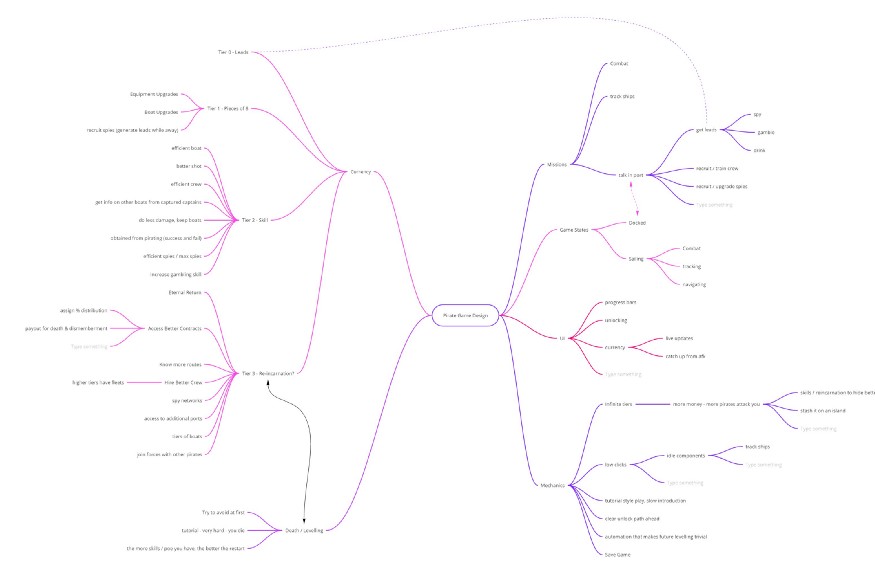
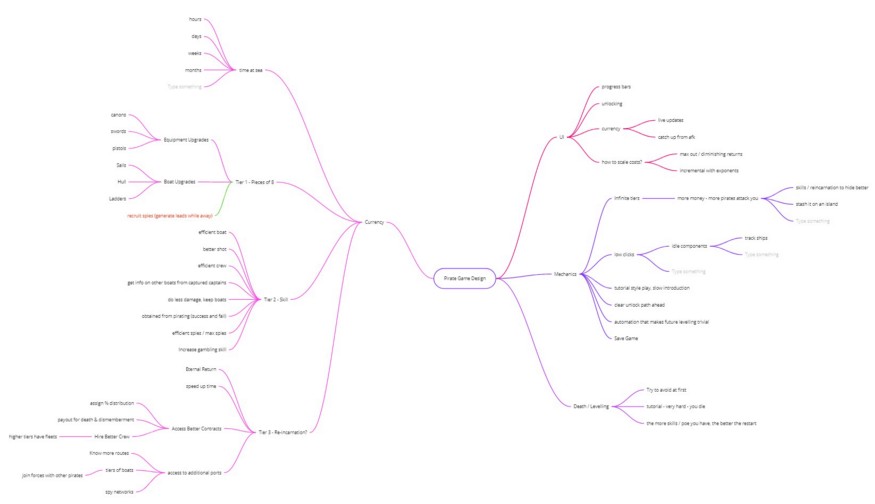
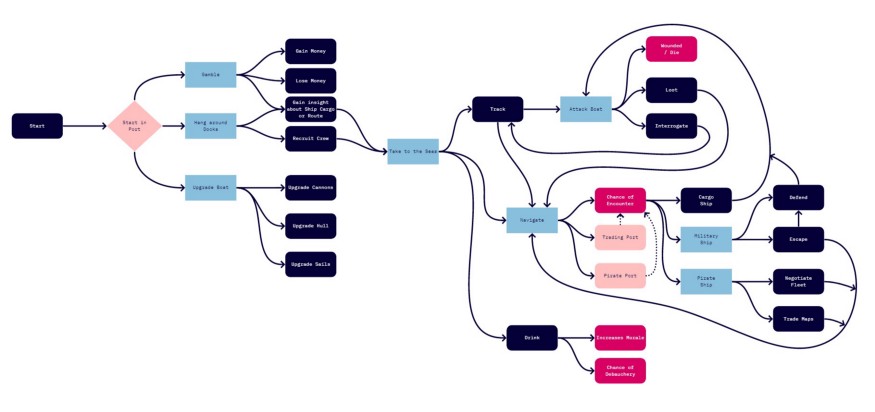
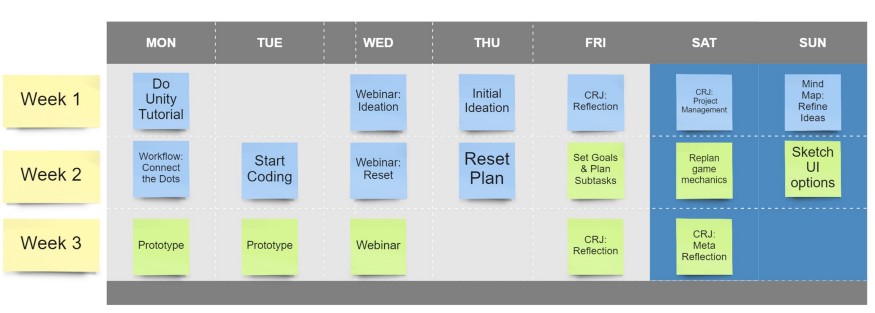
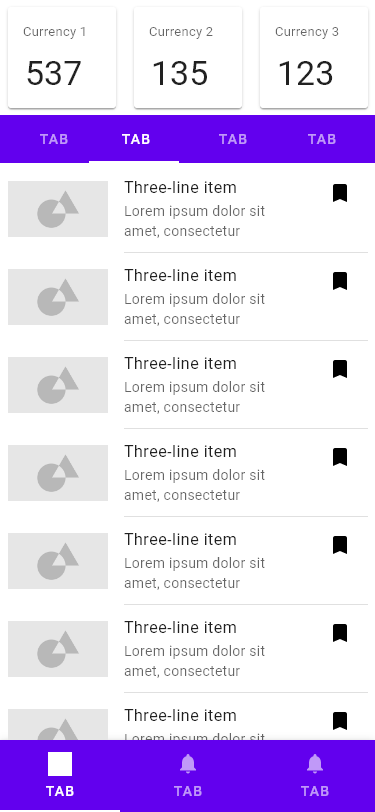
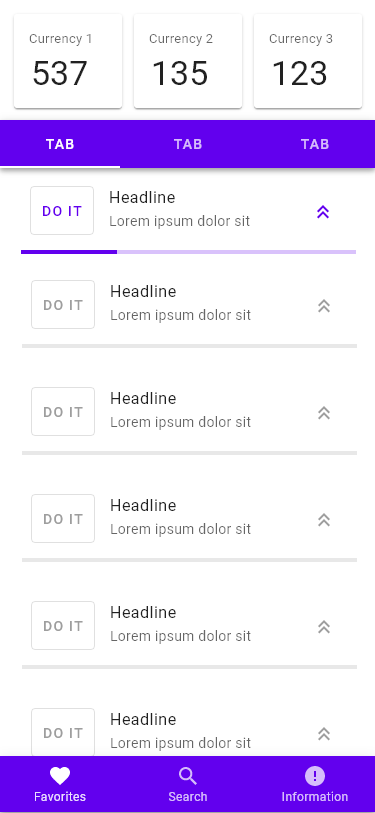
References
-
LEESON, Peter T. 2007. ‘An‐ Arrgh ‐chy: The Law and Economics of Pirate Organization’. The Journal of political economy 115(6), 1049–94.
-
DEMARCO, Tom. 2013. Peopleware: Productive Projects and Teams. Addison-Wesley Professional.